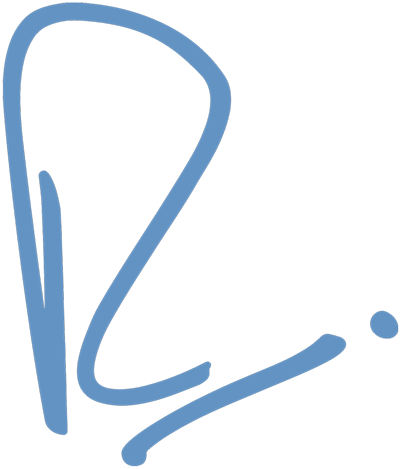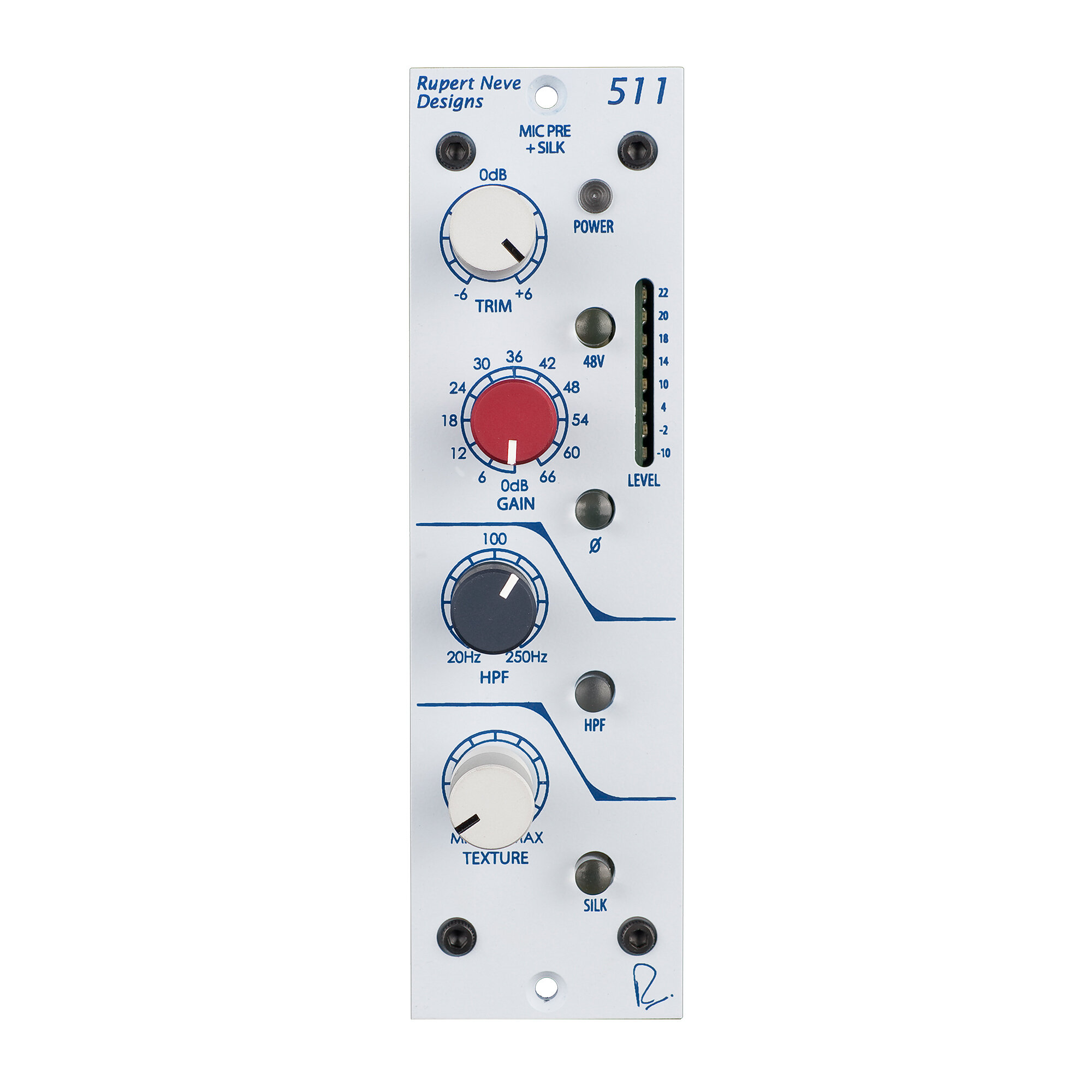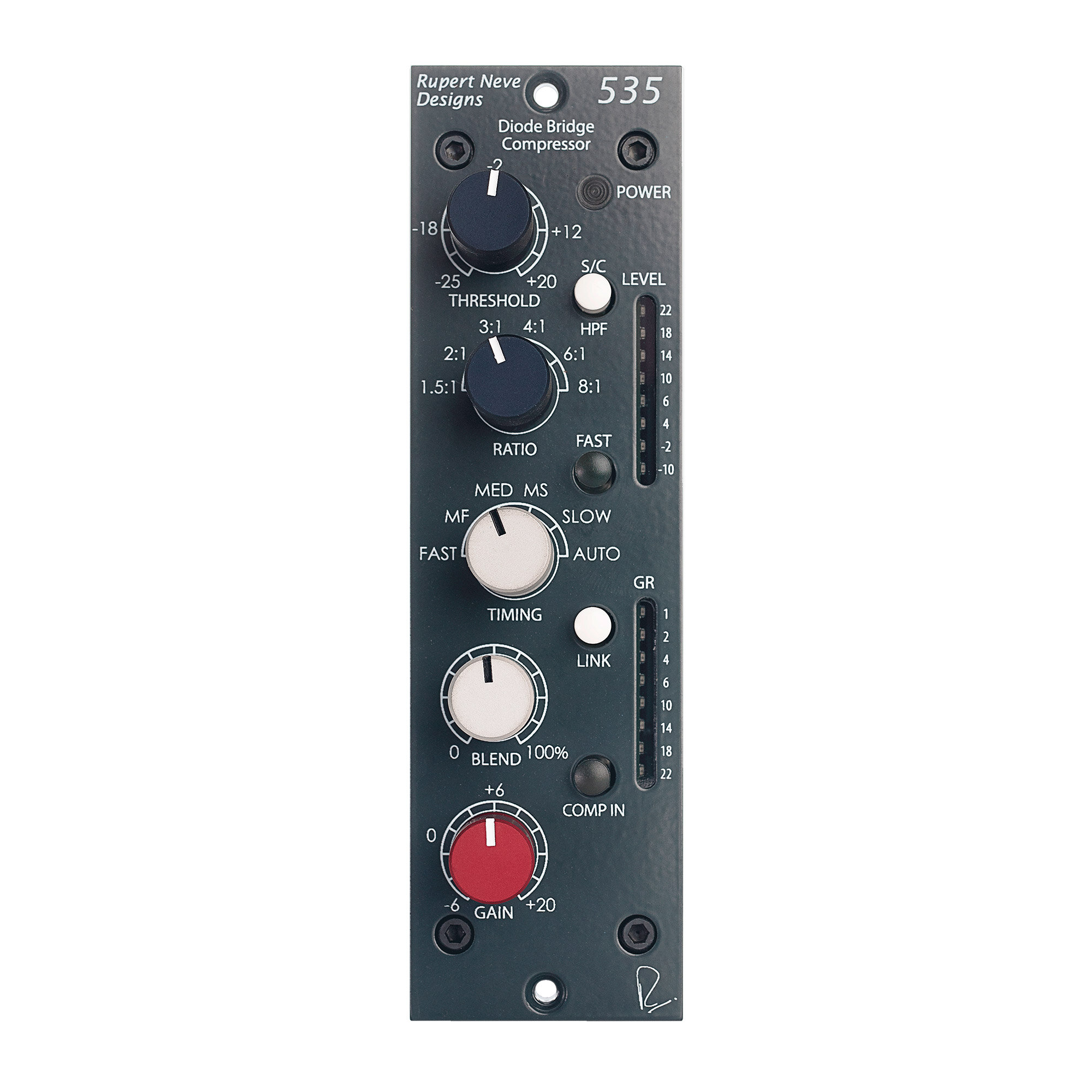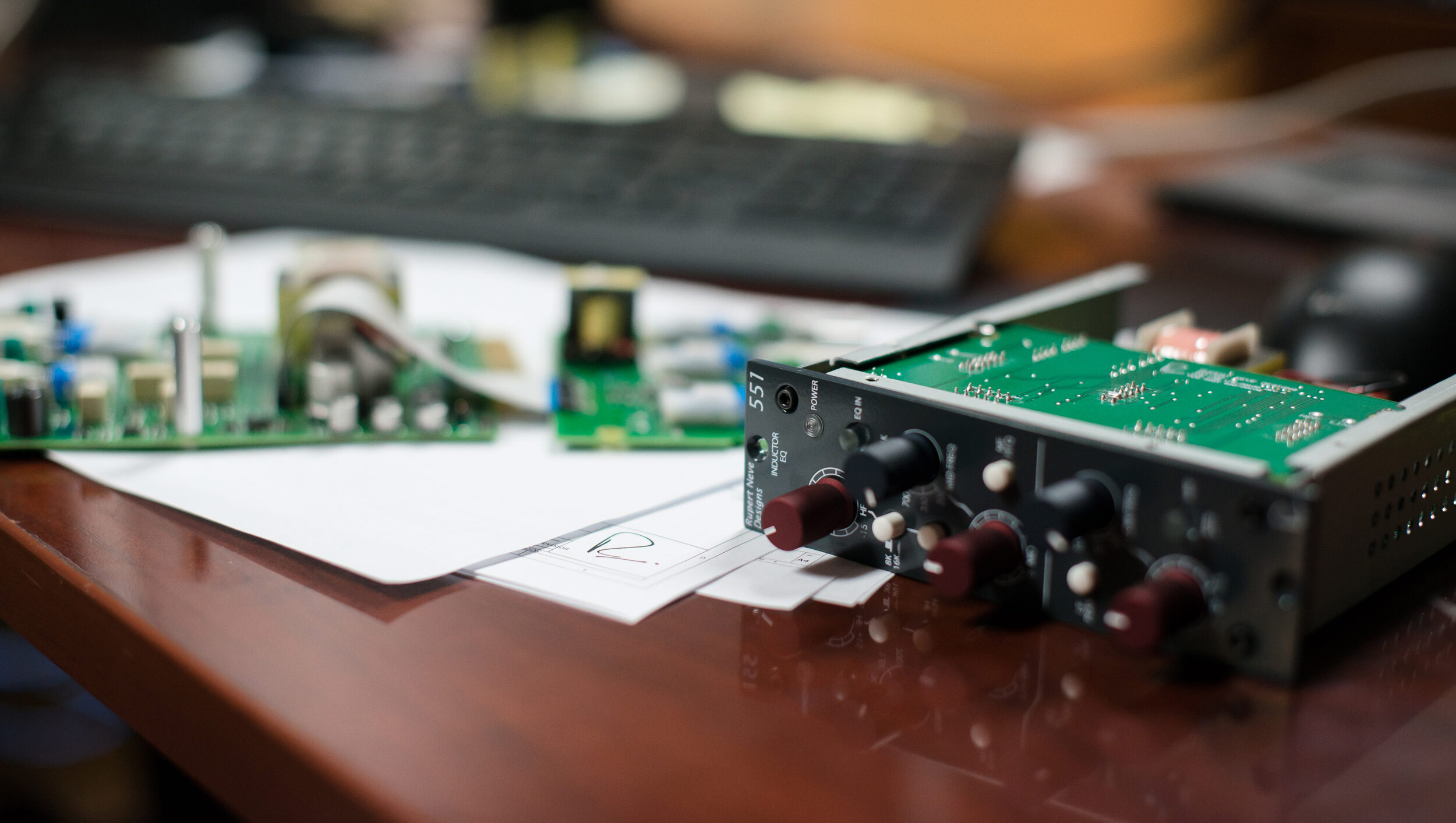
551
500 Series Inductor EQ
OVERVIEW / MEDIA / FEATURES / REVIEWS / SPECS & RESOURCESThe vintage EQ tones you know & love.
The 551 is the only equalizer for the 500 Series actually designed by Rupert Neve. Featuring 3 bands of EQ inspired by Mr. Neve’s most prized vintage designs, along with custom-wound inductors, transformers and class-A gain blocks, the 551 brings the thick, powerful lows and sweet highs of Rupert’s classics to the 500-Series format.
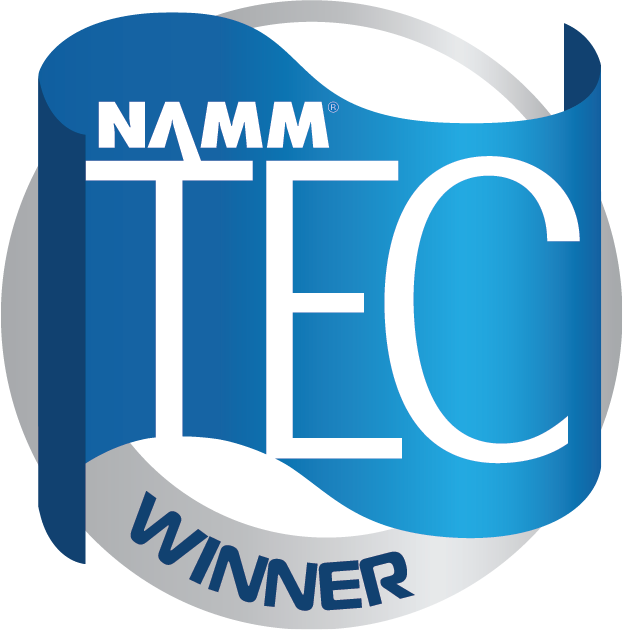
“Find a source this EQ doesn’t sound great on – go ahead, I dare you!”
The “Best-Of” EQ
The 551’s 3-band, custom-tapped inductor EQ was inspired by our favorite elements of Rupert’s vintage EQ designs. The low frequency band is designed to produce a creamy, resonant bass response similar to a vintage 1064 – but unlike the vintage modules, the LF band on the 551 can be used as either a shelf or a peak filter, adding punch, dimension, and control to your low end.
The midrange band is based on that of the 1073, ideal for sweetening vocals and instruments while bringing them forward in a mix, and its proportional “Q” response makes it well-suited for minimizing problematic frequencies. The high frequency band is a hybrid vintage / modern design, blending inductor circuitry with capacitor-based topologies to achieve vintage tones with enhanced control. The High Pass filter is a 12dB/octave design with a fixed 80Hz frequency, and can be used in tandem with the low frequency EQ to add low-end presence without clouding the source material.
As with Rupert’s most prized classic designs, each EQ section uses low-feedback, class-A discrete electronics to prevent low-level artifacts and harshness from detracting from the tonal shaping. However, this new circuit is a decidedly modern design with updated techniques and components that were simply not available 50 years ago, and is definitely not a “clone”.
What Are Inductors?
Inductors are wires wound around a coil that provide a form of frequency-dependant resistance. When they saturate, they bring out beautifully musical harmonics that give your tracks the smooth, polished sound that has made Rupert’s consoles and equipment so desirable for over fifty years. This is what makes them different from capacitor-based EQ designs, which do a great job at surgical equalization. But inductors provide the tone.
While it is certainly possible to create a functioning EQ using off-the-shelf inductors, we choose to use our own custom inductors for the 551. This attention to detail in controlling variables such as the winding and core materials in relation to the surrounding circuitry allows the 551 to capture the vitality and personality of Rupert’s classic designs.
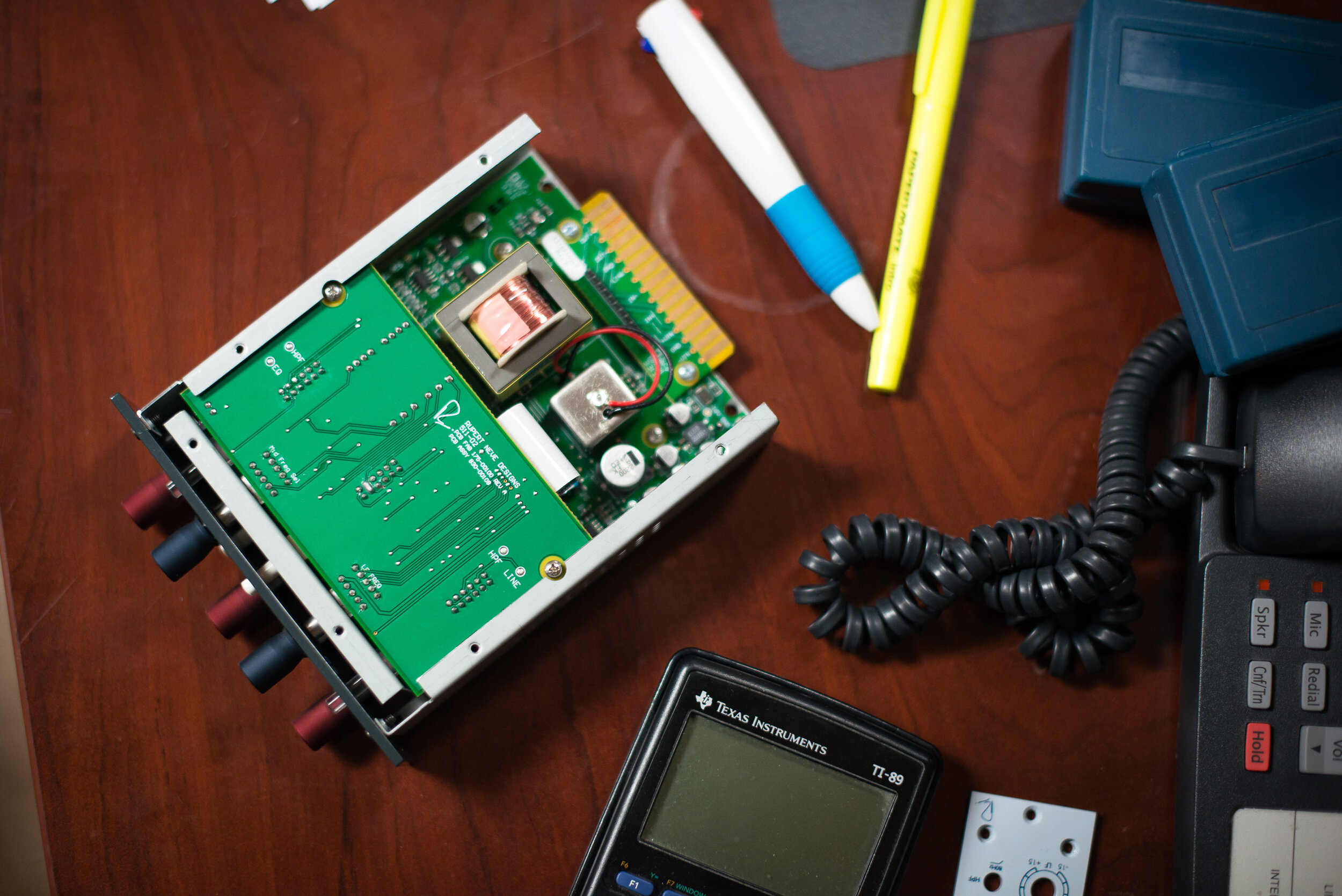

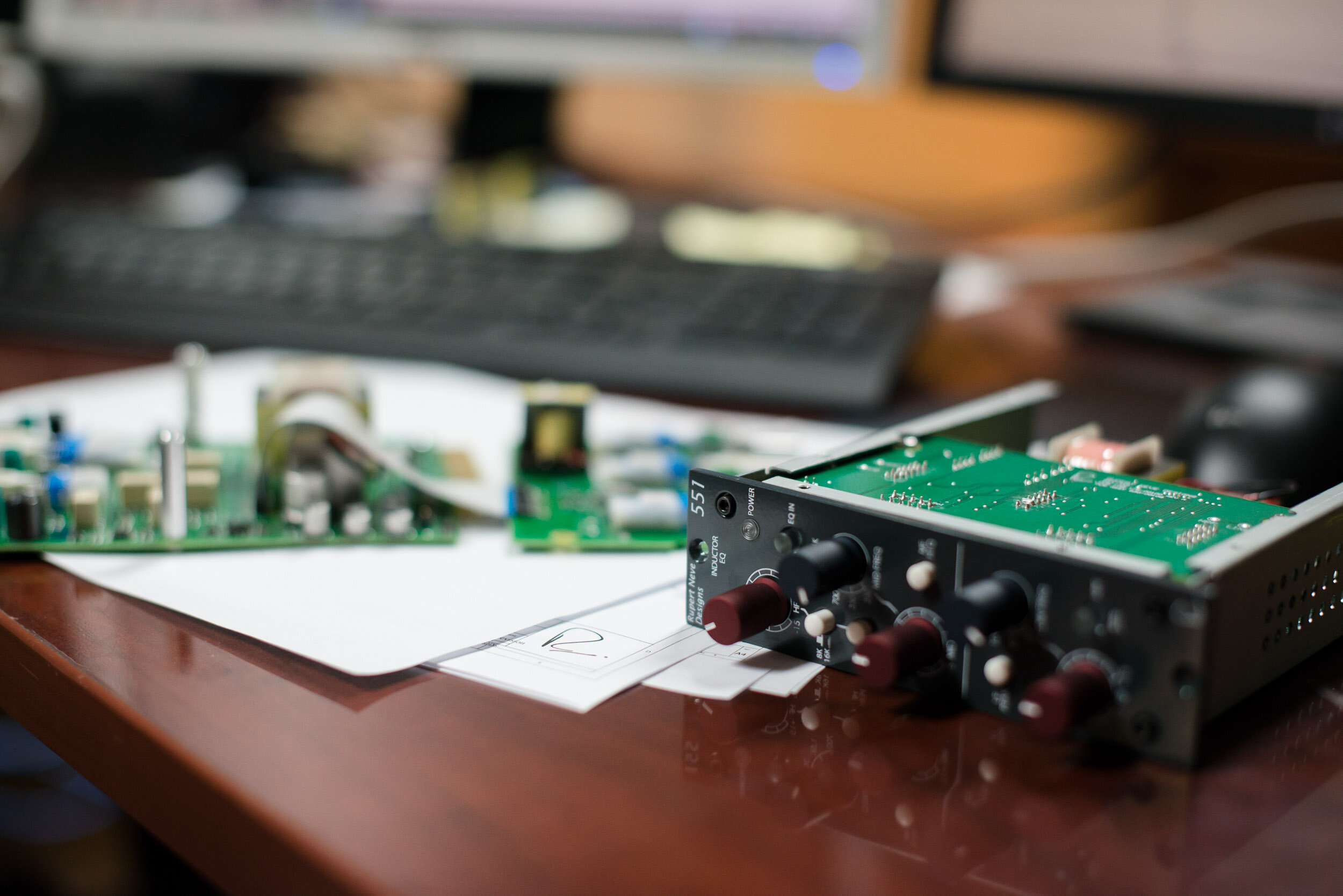
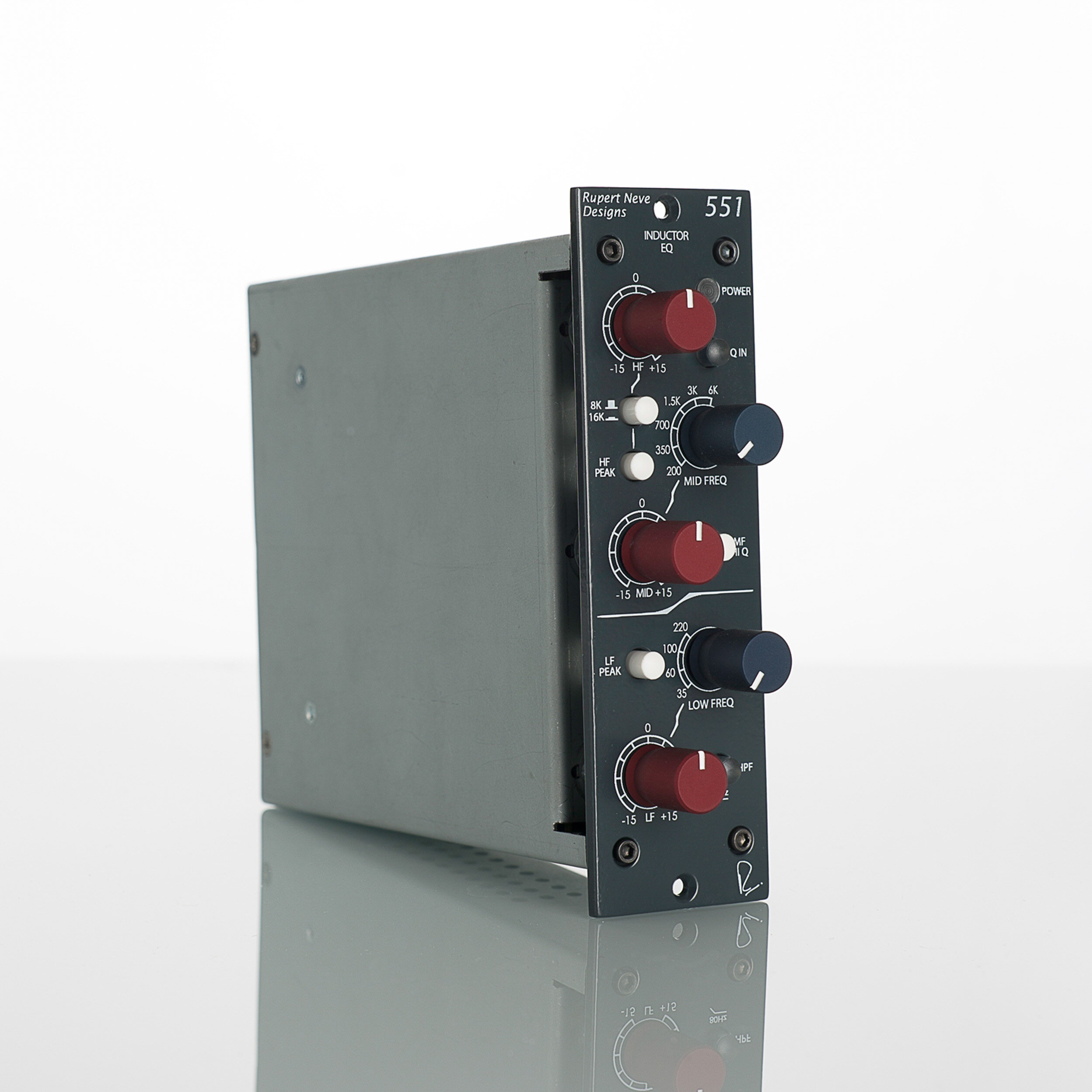
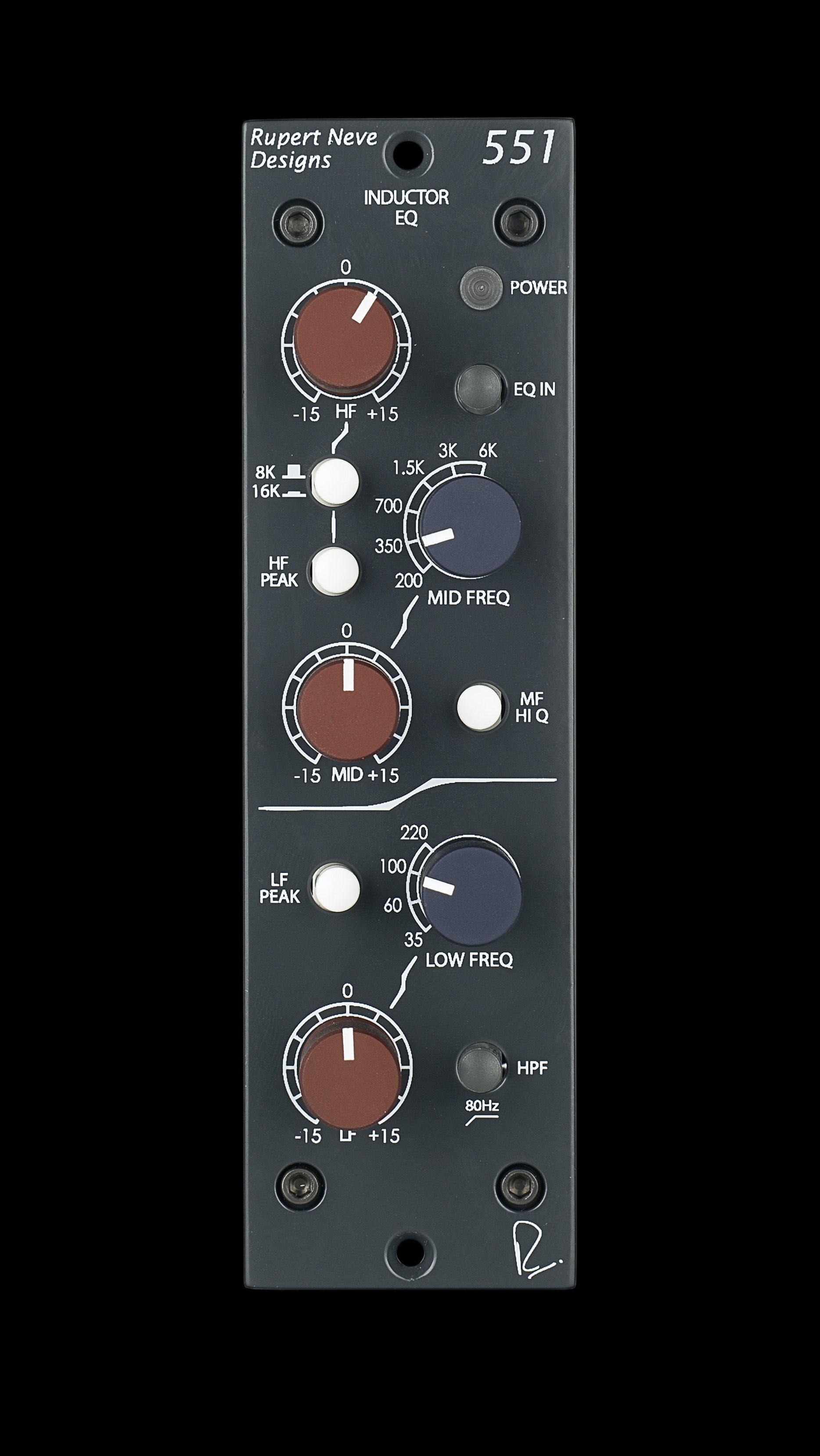
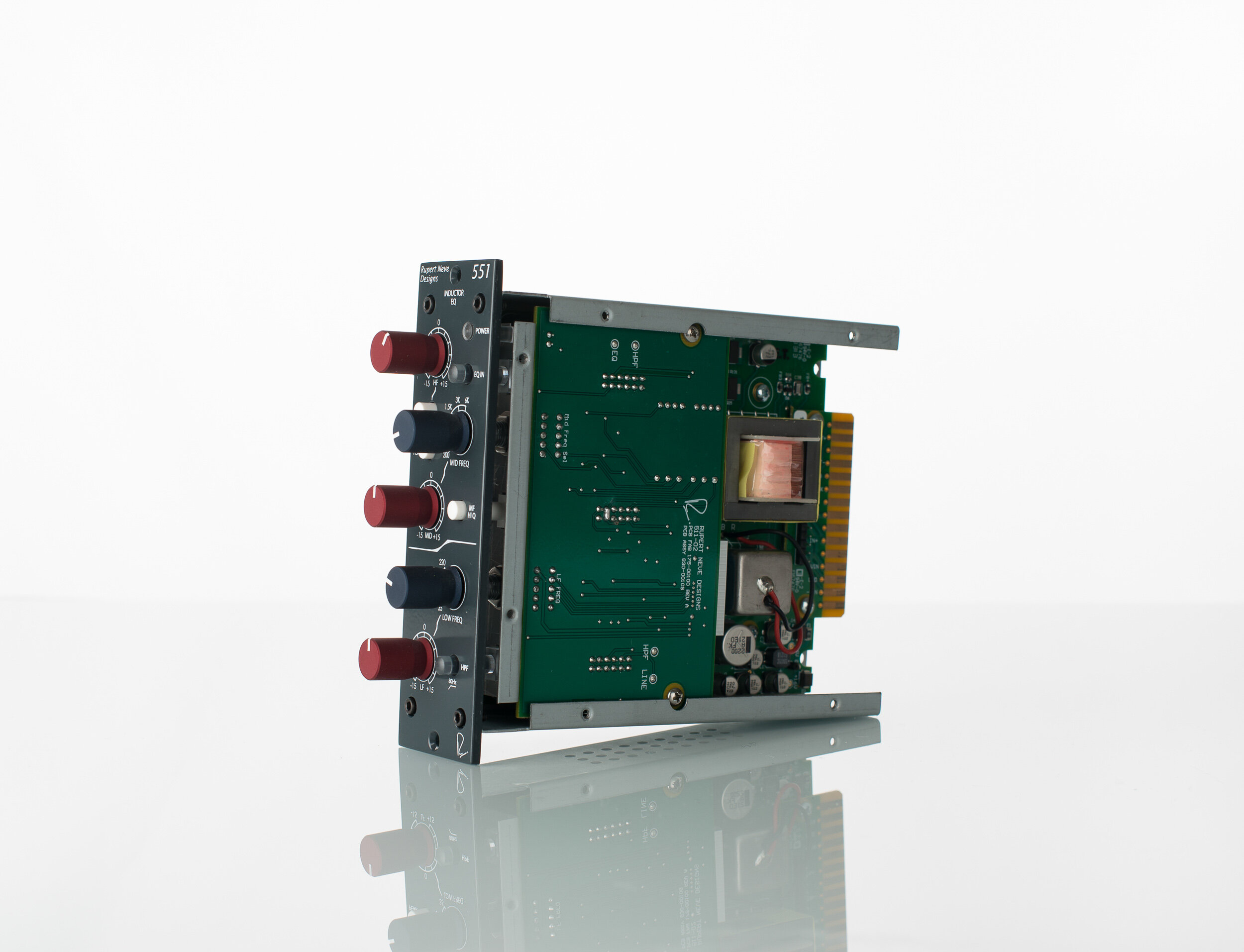


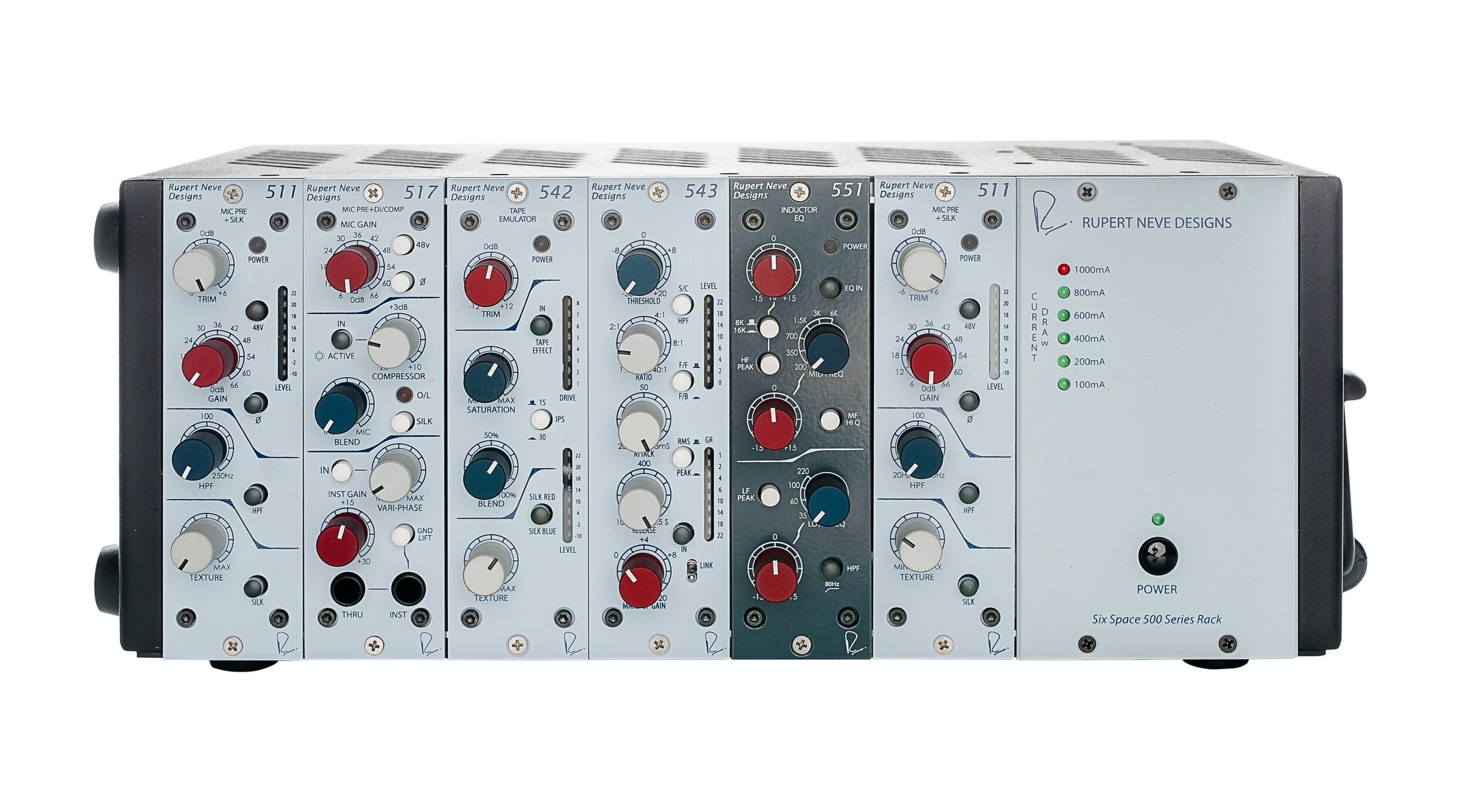
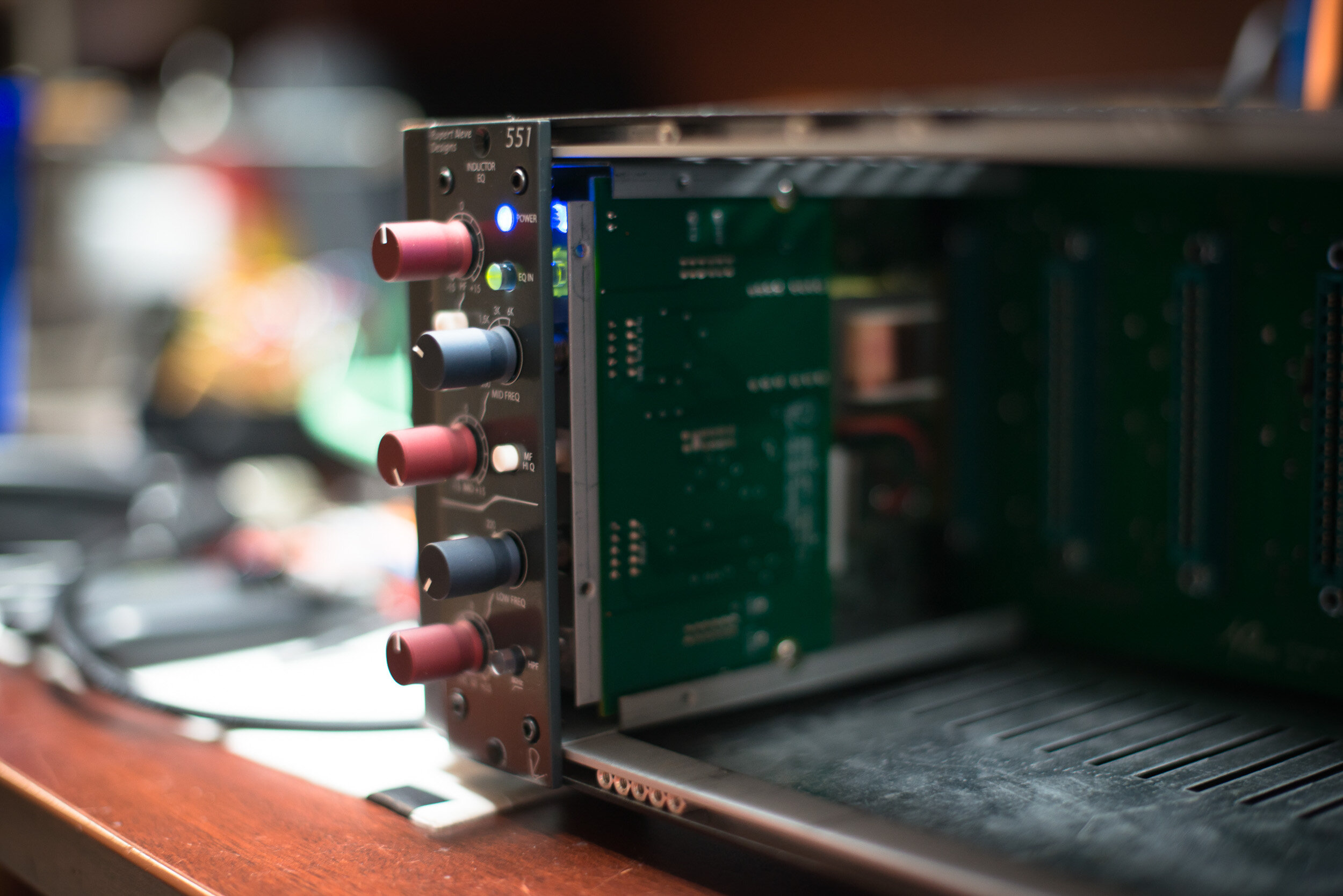
EQ IN
Engages all bands of the equalizer except the high-pass filter.
8K / 16K + HF LEVEL
With the switch out, the center or corner frequency of the high band is 8 kHz. With the button pressed, the center or corner frequency changes to 16 kHz. Between this switch and the HI PEAK switch, you have 4 different EQ curves to finesse the high frequency content. The HF knob adjusts up to 15 dB of boost or cut at the selected high frequency.
HI PEAK
When the button is out, the high frequency band operates in shelf mode, boosting or cutting above the corner frequency at approximately 6 dB/octave. Below the corner frequency the amount of boost or cut gradually diminishes. With the HI PEAK button pressed, the high frequency band changes to peak mode with a bell shaped boost or cut curve. The peak mode utilizes an inductor and capacitor circuit to create the bell-shaped curve.
MID FREQ + MID LEVEL
The MID FREQ rotary switch has 6 positions to select the center frequency of the mid band EQ stage. This circuit utilizes an inductor and capacitors to shape the EQ curve, in the same way as Rupert Neve’s console designs of the 70’s. The frequencies chosen are 200 Hz, 350 Hz, 700 Hz, 1.5kHz, 3 kHz and 6 kHz. 200 Hz is especially useful for cuts on individual tracks within a dense mix. The MID knob adjusts up to 15 dB of boost or cut at the selected mid frequency.
MID HI Q
The resonance (or Q) of the mid band at maximum boost is typically 2 when the button is out. When the MID HI Q is pressed at maximum boost, the Q narrows to approximately 3.5. The Q widens nicely with less boost or cut, as is typical for passive EQ circuits.
HPF
Engages an 12dB per octave High Pass Filter with an 80Hz corner frequency.
LOW FREQ + LF LEVEL
The LOW FREQ rotary switch has 4 positions for selecting one of four corner or center frequencies for the low band EQ section. The frequencies are 35 Hz, 60 Hz, 100 Hz and 220 Hz. The LF knob adjusts up to 15 dB of boost or cut at the selected low frequency. Cut can be used as a variable (and perhaps more gentle) alternative to using the HPF.
LO PEAK
When the button is out, the low frequency band operates in shelf mode, boosting or cutting below the corner frequency. Above the corner frequency the amount of boost or cut gradually diminishes at approximately 6 dB/octave. With the LO PEAK button pressed the low frequency band changes to peak mode with a bell shaped boost or cut curve.
REVIEWS
“This EQ was always firm and thick sounding while maintaining plenty of focus. It was hard to move the module to other sources and the need/desire for several more of these compact beasts was made quickly apparent to me. When I find something I like that works well for a specific track, I tend to leave it there until it no longer suits the need. The 551 fit the bill for so many sources that a full rack of them would always be in service at my studio…Find a source this EQ doesn't sound great on – go ahead, I dare you! Highly recommended.”
”The 511 mic preamp is a joy to use, delivering clean or vintage characters at will, and the 551 EQ makes the perfect partner delivering a very classy sound with well-chosen EQ options.”
Hugh Robjohns / Sound On Sound
“There’s a wonderful silky smooth quality to the top end of this EQ, which perfectly captures that British sound which Rupert Neve essentially defined…The 551 is one of the best-sounding EQs we’ve ever heard.”
“Really musical and effective EQ. Everything sounds better through these; I purchased a pair.”
“Powerful, beautiful EQ. Even running a signal through at unity does something special to the sound.”
“Bass tracks sound more focused and punchy, vocals sit in the mix with little effort, I’m gonna need more of these, it is making me strive for better sounds from the start of a project.”
“Beautiful sounding piece of kit. Dead quiet. Musical. Powerful. A fantastic bargain. I’m buying more of these as soon as I can sell some others I have been using. Destined to be a studio classic.”
“Sounds like a 1073 with more butter in the low mids.”
Customer Reviews via vintageking.com

SPECIFICATIONS & DOWNLOADS
EQUALIZER BYPASSED
NOISE
Measured at Main Output, un-weighted, 22Hz-22kHz, source impedance 40 Ohm balanced. Noise specifications may vary depending on which 500 series chassis is being used, and / or interference from stray magnetic fields.
Better than -102 dBV
FREQUENCY RESPONSE
Main output, no load: +/- 0.1 dBu from 20 Hz to 31.5 kHz, -1 dB @ 120 kHz
MAXIMUM OUTPUT LEVEL
23.25 dBu
TOTAL HARMONIC DISTORTION AND NOISE
@ 1 kHz, +20 dBu output level, no load: Better than 0.0025%
@ 20 Hz, +20 dBu output level, no load: 0.13% Typical (2nd and 3rd harmonic)
HIGH PASS FILTER
-2.7 dB @ 80 Hz
Slope: 12 dB/Octave
EQUALIZER ENGAGED
NOISE
Measured at Main Output, un-weighted, 22 Hz - 22 kHz, source impedance 40 Ohm balanced.
Better than -94 dBV
FREQUENCY RESPONSE
Main output, no load: +/- 0.25 dBu from 20 Hz to 45 kHz, -2 dB @ 120 kHz
MAXIMUM OUTPUT LEVEL
23 dBu
TOTAL HARMONIC DISTORTION AND NOISE
@ 1 kHz, +20 dBu output level, no load: Better than 0.009%
@ 20 Hz, +20 dBu output level, no load: 0.13% Typical (2nd and 3rd harmonic)
POWER REQUIREMENTS
120mA on +16VDC
110ma on -16VDC
UNIT DIMENSIONS
1x 500 Series Module: 1.5” W x 5.9” D x 5.25” H
(3.8 cm W x 15 cm D x 13.3 cm H)
UNIT WEIGHT
1.5 lbs. (0.7 kg)
SHIPPING DIMENSIONS
10” W x 8” D x 3” H
(25.4 cm W x 20.3 cm D x 7.6 cm H)
SHIPPING WEIGHT
3 lbs. (1.4 kg)
FREQUENTLY ASKED QUESTIONS
Yes, all of our modules are designed within the 500 Series specification and we are not aware of any instances where they have not worked as intended.
Yes, a pair of 551s can definitely be used for stereo signals – but the controls cannot be linked, so you will have to set each unit individually (and most likely identically).
The 551 is the same inductor EQ design, but the lower voltage and different line driving circuitry do have slightly different performance overall.
Yes, this is normal. When the frequency positions are changed, the switch momentarily breaks the connection in the audio path, which can cause a click. (Note: how much of a click or pop you hear may also be dependent on the source material, as well as the amount of boosting you’re doing with the control). On the LF band, you may also hear a slight mechanical click from inside the unit itself. That’s the sound of relays switching to change the frequency selection.
We utilize an electrogalvanized chassis to shield the internal circuitry from interference. With this process, it isn’t possible to “finish” the chassis metal (i.e. polishing or anodizing) so the machining marks from forming the metal will be visible. In normal operation inside a 500 series rack, this metal will never be visible.
We use standard 4-40 ¼" screws to secure our 500 series rack modules. Each of our modules and our R6 and R10 racks include these screws. Please contact our service department if you have questions or need additional screws.
